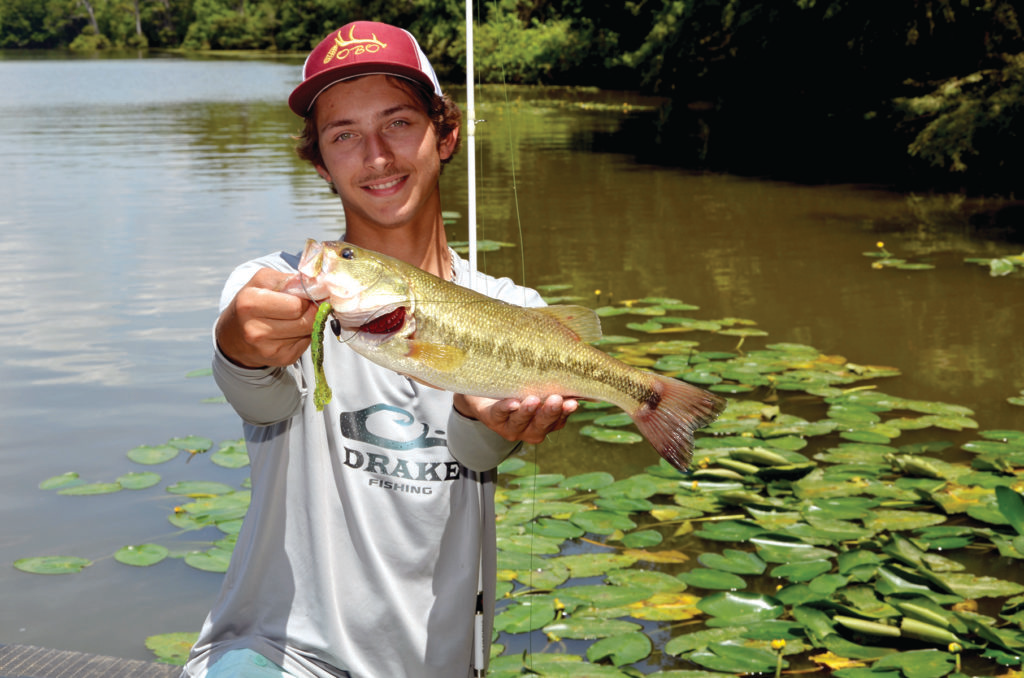Anglers usually catch the largest bass of the year just before and during the spring spawning season when large females swell with roe. An egg-laden bass could weigh several pounds more just before spawning than during the summer.
Largemouth bass begin spawning when water temperatures reach about 63 to 68 degrees. In southern Alabama, they could begin spawning in February. Farther north, they might start in March. Spawning usually peaks in April, but could extend into June.

When spawning, male bass wallow out saucer-shaped nests in shallow waters. Many people roam the shallows looking for bedding bass. They might spend hours casting to one particularly large fish.
“Sight fishing is like hunting,” says Shaw Grigsby, a professional bass angler. “The challenge is finding the fish. Once we find them, we can often get them to bite. Bass on the beds don’t feed. They grab baits instinctively to protect their eggs and fry.”
While on the nests, bass eat very little, but males vigorously attack anything that might pose a threat to the eggs or fry, such as crawfish, bluegills, aquatic salamanders and other predators. Therefore, throw baits that mimic these egg raiders. Some good lures for bed fishing include soft-plastic creatures that resemble crawfish and salamanders. Baits that mimic small fish like bluegills can also work.
“Bed fishing can be highly productive in the right spot,” says Terry Segraves, a professional bass angler. “I’ve caught bedding fish with everything from finesse worms and jigs to lipless crankbaits. To get a reaction, sometimes I let a bass look at the bait and then jerk it away just before it eats it. Do that several times and it’ll murder it when it gets aggravated enough.”
Bedding bass typically won’t chase baits out of the nests. Repeatedly drag soft-plastic lures through the beds. Sometimes, leave lures in the bottom of the nest for long periods. Bass routinely pick up foreign objects to remove them from the bed.
“Many people try to aggravate a fish into biting,” says Terry Scroggins, a professional bass angler. “I prefer a more subtle approach. My number one bedding bait is a soft-plastic crawfish that looks like a natural predator. A drop-shot is another good bedding bait, especially for fish that are hard to catch. I cast past the bed, crank the bait over the surface and drop it so it flutters down into the bed. I let it sit there as long as I can.”
After finding nests, some people thrust a stick or other subtle object into the bottom to mark it. After the boat leaves, fish quickly return to the bed. Anglers can go elsewhere for a while and then return to fish that area. Stop at extreme casting distance to avoid spooking the bass and throw at the marker.

Garrett Dixon of Citronelle, Ala. shows off a bass he caught on a jig tipped with soft-plastic creature bait while fishing the Mobile-Tensaw Delta.
Photo by John N. Felsher
“Most people get too close to the fish,” Scroggins says. “If anglers can see the fish, the fish can see them. In clear water, fish may spook so back away and make long casts. Sometimes, I mark the bed with a tomato stake and come back to it.”
From a distance, Scroggins tosses finesse worms, craw-worms or other temptations behind the nest and drags them into the bed. He leaves baits motionless for long periods, occasionally giving the rod a little shake. Even with no other action, tentacles and appendages on a soft-plastic bait twitch and undulate slightly with any water movement. Just that bit of subtle action could provoke a strike or force the fish to remove the bait from the nest.
After laying her eggs, the female moves off the nest until next spring. She rests for a while to recuperate from the rigors of spawning then starts looking for prey to replenish her energy supplies. After the spawn, throw lures that resemble bluegills.
“After bass spawn, bluegills spawn in the same area,” says Alton Jones, a former Bassmaster Classic champion. “Then, it’s payback time. In the spring, I throw a lot of baits that mimic bluegills, like shallow-running crankbaits in a firetiger pattern or chartreuse with a blue back. I also throw a lot of golds and reds.”
A healthy female largemouth in her prime can produce about 5,000 eggs per pound of body weight. During spawning season, don’t keep bass off the beds very long. Always handle bass with care, especially large females swollen with roe, and return them to the water as quickly and gently as possible to protect future generations.
John N. Felsher is a professional freelance writer who lives in Semmes, Ala. He also hosts an outdoors tips show for WAVH FM Talk 106.5 radio station in Mobile, Ala. Contact him at [email protected] or through Facebook.




